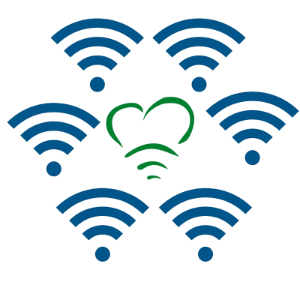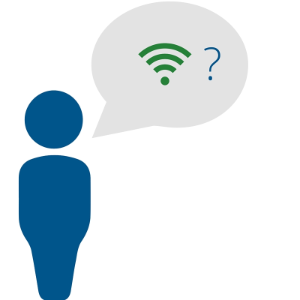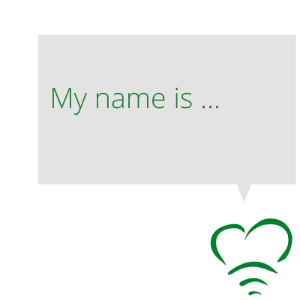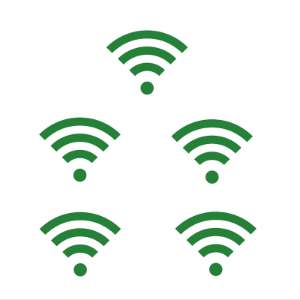You Are Connecting Your Access Point And It Is Set To Root. What Does Extended Service Set Id Mean?
What is an SSID and why is it of import how it is ready upwardly? This is a unproblematic guide to choosing the best SSID for your network.
What is an SSID?
SSID is brusk for Service Set Identifier. All wireless networks take an SSID, in everyday speech often known but as network names or Wi-Fi names. You need to know or discover this name in order to connect to a wireless network, normally in combination with a countersign.
You tin commonly change the SSID setup in the settings of your router (or other wireless access bespeak). A network name cannot be more than 32 characters long, but other than that, there are few restrictions on what you tin can choose as the SSID.
1. Make the network proper noun easily recognizable

Technically speaking, the name of your network does not need to be unique, but information technology is highly practical to take an SSID that volition stand out on the list of available networks--unless, of course, there are no other networks effectually.
Usually, your router, extender, or other wireless access point comes pre-configured with i or more SSIDs. If your neighbours have equipment from the same service provider and vendor, information technology's easy to end up with a list of very similar-looking and sounding names.
This can be both disruptive and frustrating, peculiarly for guests and others that are connecting for the starting time time.
You are costless to call your network whatever you want, so why leave it as an advert for the vendor?
ii. Observe out Whether You Take Band Steering

The most common reason to have more than one SSID on a single admission betoken is using one SSID per frequency band. This may be pre-configured past your vendor or service provider. Typically, one SSID will contain the number five, and the other name the number two, pointing to the five GHz and ii.4 GHz frequency bands respectively. For instance: my_wifi_2G and my_wifi_5G
- If your router/admission point has band steering, you should only have a single SSID for both bands, so that the admission point can pick the best ring supported for each device and the user does not need to think nigh it.
- If you practice non have band steering, you are better off with 2 SSIDs, but will need to keep in listen which devices support v GHz Wi-Fi and which do not. Naming the SSIDs to indicate new versus onetime equipment rather than numbers or standards may make this easier to manage and recall.
If y'all do not have band steering, but still go with a single SSID, you are essentially playing Wi-Fi roulette. Every device connecting volition be making its own decision on which signal is the stronger and more appealing. In well-nigh cases this volition be the 2.4 GHz signal, fifty-fifty for devices that would accept performed much better on the five GHz band.
You can read more about frequency bands and how band steering works in Why Band Steering Ways Better Wi-Fi.
How to Detect Out What Your Devices Support
Band steering is becoming increasingly common in wireless access points. If you are in doubt virtually what is supported by your router, extender, or other access bespeak, consult its documentation or contact your service provider if they supplied the equipment. Knowing what Wi-Fi technologies your computers, smartphones, and other devices support, is besides a proficient idea.
What you want to look for is:
- "Dual band" or "802.eleven air-conditioning" in both routers/access points and wireless devices, ways the 5 GHz frequency band is supported. If the latest standard mentioned is 802.eleven n, it may have back up for 5 GHz, simply you may demand to check the documentation more than closely to find out.
- "Band steering" in your router or other wireless admission point.
3. Brand a Unproblematic Guest Policy

Do you oftentimes have visitors that utilise their own devices on your wireless networks? For example your kids' friends? And so having a separate guest network with its own SSID and password is a good idea.
Keep in mind that:
- Invitee networks should be configured on the aforementioned equipment as the main Wi-Fi network to avert creating interference betwixt the two.
- If you do not have ring steering, consider having two SSIDs for your guests as well.
Annotation that having a large number of SSIDs on the same access betoken may negatively affect performance. We suggest you lot not to overdo it by creating multiple categories of users.
4. Make Your Network Proper name(s) Visible

The SSID itself is not a matter of security, merely on your access point, you can configure the SSID to be visible or subconscious. A subconscious SSID means it will not exist broadcast, and will not show up when your average Wi-Fi capable device is searching for available networks.
For convenience, invitee networks should always exist visible, or you will likely cease up spending an inordinate amount of time on helping your guests connect to the network.
Hiding your principal network's SSID is often recommended as a security measure. Nevertheless, consider that:
- Whatever Wi-Fi scanner will still exist able to detect your network.
- Hiding your SSID may negatively bear upon functioning, because more than requests are required to connect.
For performance reasons, nosotros therefore recommend not hiding your SSID.
5. Name Any Repeaters Sensibly

If your home Wi-Fi is made upward of a router and one or more repeaters or extenders, you are, in reality, dealing with multiple networks. You should carefully consider whether or not these networks are capable of sharing an SSID.
When moving effectually with a wireless device such as a smartphone, it will usually tend to cling to the get-go access point it continued to, fifty-fifty when at that place is another i that is closer and could provide meliorate coverage and functioning.
This phenomenon is known equally a "glutinous client", which you tin read more most in Sticky Clients: When Devices Cling to a Bad Connexion.
The most constructive solution to the sticky client problem is client steering, a technology that ensures that multiple access points in a network piece of work together to determine where devices should connect to get the all-time functioning.
How to Choose the Best SSID for Your Repeater Network(s)
- If your equipment supports any sort of customer steering, a single SSID is by far the easiest and the virtually practical way to get.
- If your equipment does not back up client steering, you accept two options:
- If you pick a shared SSID, y'all leave it up to each device to figure out where to connect. Some devices do a very adept task with this by themselves. With others, you may have to restart Wi-Fi on the device to force a new scan and option up a change in point strength.
- Leaving each admission point with its ain SSID is definitely cumbersome, but does make it easier to run into where you are connected and to manually change where you lot connect. In this case, we strongly recommend naming admission points after their locations in the dwelling for ease of use, rather than having to remember (and explain to visitors) which goes where.
Article by January Pedro Tumusok and Jorunn D. Newth
Source: https://eyenetworks.no/en/guide-to-selecting-best-ssid/
Posted by: mcleanaparich.blogspot.com


0 Response to "You Are Connecting Your Access Point And It Is Set To Root. What Does Extended Service Set Id Mean?"
Post a Comment